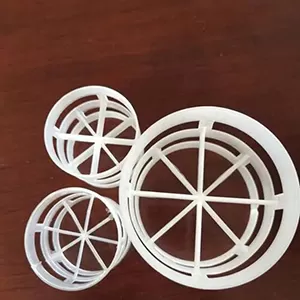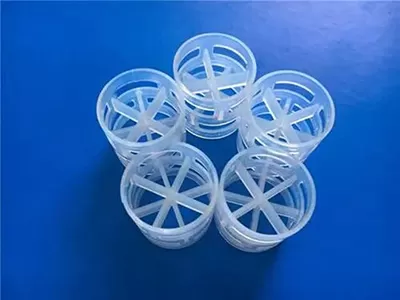Plastic
pall ring packing is widely used in various industrial processes, and its material directly affects its performance and application. This article will introduce the common materials of plastic Pall ring packing and their characteristics.
Polypropylene (PP) is one of the most commonly used materials for plastic Pall ring packing. It has good chemical resistance, being able to withstand the corrosion of most acids, alkalis, and organic solvents, which makes it suitable for many chemical processing environments. PP also has a relatively low density, resulting in lightweight packing that is easy to handle and install. Additionally, it has good mechanical strength and toughness, ensuring stable performance during use. However, PP has a relatively low melting point, so it is not suitable for high - temperature applications where the temperature exceeds its heat - resistant limit.

Polyvinyl chloride (PVC) is another material used for plastic Pall ring packing. It exhibits excellent resistance to acids and alkalis, especially dilute acids and alkalis, making it applicable in some chemical industries with moderate corrosion conditions. PVC has good dimensional stability, which helps maintain the structural integrity of the Pall ring packing during long - term use. It also has a relatively low cost, which is an advantage in terms of economy. However, PVC has poor heat resistance and may soften or deform at higher temperatures, limiting its use in high - temperature environments.

Polytetrafluoroethylene (PTFE), also known as Teflon, is a high - performance material used for plastic Pall ring packing. It has exceptional chemical resistance, being resistant to almost all known chemicals, including strong acids, strong alkalis, and various organic solvents. This makes PTFE Pall ring packing ideal for extremely harsh chemical environments. PTFE also has excellent high - temperature resistance, able to maintain its properties at high temperatures up to 260°C. However, PTFE is relatively expensive, which increases the cost of the packing, and it has lower mechanical strength compared to PP and PVC, requiring careful handling during installation and use.
Polyethylene (PE) is sometimes used to make plastic Pall ring packing, especially low - density polyethylene (LDPE) and high - density polyethylene (HDPE). LDPE has good flexibility and impact resistance, while HDPE has higher rigidity and chemical resistance. PE is resistant to many acids, alkalis, and salts, making it suitable for some general industrial applications. It is also relatively low in cost and has good processability. However, like PP, PE has limited heat resistance and is not suitable for high - temperature operations.
In summary, plastic Pall ring packing is made of various materials such as polypropylene, polyvinyl chloride, polytetrafluoroethylene, and polyethylene, each with its own unique characteristics in terms of chemical resistance, heat resistance, mechanical properties, and cost. The choice of material depends on the specific application environment, including the type of medium, temperature, and pressure, to ensure the packing can perform effectively and durably.



